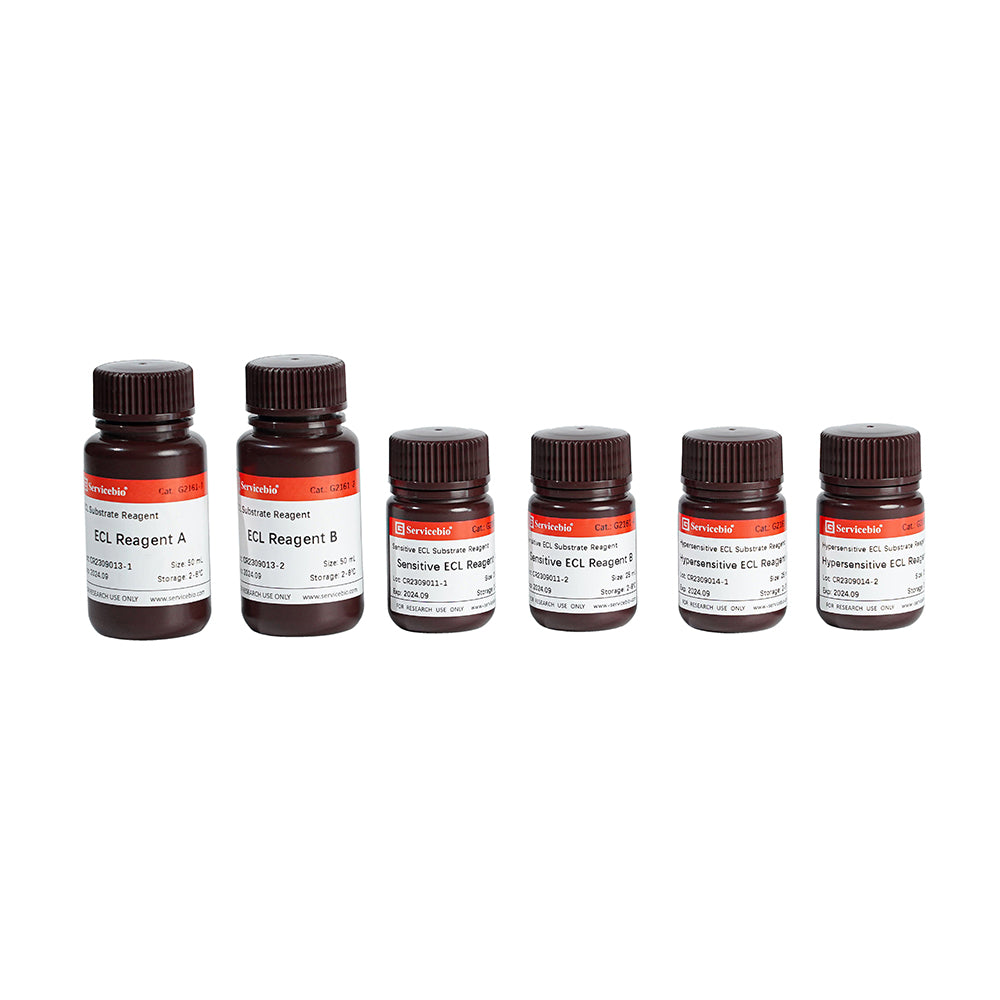Description
Sensitive ECL Chemiluminescence Substrate Reagent Kit (picogram levels)
Cat # G2074
|
|
|
|
|
Sensitive ECL Chemiluminescent Substrate Reagent Kit (picogram level) |
G2074-50ML |
2×25 mL |
|
G2074-100ML |
2×50 mL |
This product is a chemiluminescence kit with high sensitivity, the basic principle is luminol-based chemiluminescence; it can react with horseradish peroxidase (HRP) coupled to the secondary antibody and emit light, which can be detected by X-ray film exposure or other imaging methods (e.g., fluorescence or chemiluminescence imaging equipment); Low concentration samples can still detect signals and save samples. After incubation with low concentration of antibodies (primary antibody and secondary antibody), the signal can still be detected and precious antibodies can be saved, and the signal value is at least 10 times higher than that of ordinary ECL chemiluminescence kit (G2014).
Ship with wet ice; Store at 2-8℃, valid for 12 months.
|
|
|
|
|
|
G2074-1 |
Sensitive ECL Reagent A |
25 mL |
100 mL |
|
G2074-2 |
Sensitive ECL Reagent B |
25 mL |
100 mL |
|
Manual |
1pc |
||
- Reagent A and Reagent B are mixed in equal volumes to make ECL working liquid before application to the blot.
- In the Western Blot experiment, the PVDF membrane (or NC membrane) was incubated with the secondary antibody, washed several times, and the excess liquid was removed by filter paper; the membrane was placed in the middle of two pieces of clean cling film (or PE gloves), and the ECL working solution was added to cover the surface of the membrane, and the process should be completed carefully to avoid the formation of air bubbles between the membrane.
- After the full reaction, use filter paper or absorbent paper to absorb the excess ECL working liquid, and then carry out tablet pressing test or fluorescence imager detection.
- Develop and fix the pressed film with developing and fixing reagents (recommended G2019, G2023, G2024) (ignore this step for fluorescence imager exposure); adjust the exposure conditions according to the intensity of luminescence.
- Be sure to change the pipette tips during pipetting of Reagent A and B to avoid cross-contamination, which may result in the failure of active components.
- Please wear gloves and use clean equipment such as tweezers to avoid contamination by exogenous proteins and metal ions during contact with the membrane.
- Sodium azide inhibits HRP activity and all related reagents should be avoided.
- lease use the ECL working solution within one day, do not leave it until the next day, so as not to affect the accuracy of the experimental results.
- Please close the bottle tightly and keep it away from light to prevent failure after use. Especially Reagent B, which contains oxidants and is easy to be reduced and become ineffective.
- The ECL Chemiluminescence Substrate Reagent kit selection refer to Table 1, the recommended dilution ratio of the first antibody and the second antibody are from self-developed antibody.
- Common problems and solutions of ECL chemiluminescence detection refer to Table 2.
- ECL chemiluminescence kit Reagent A/B are harmful to human body, must be careful when handling, pay attention to effective protection, avoid direct contact with the human body or inhalation of the respiratory tract.
- Wear suitable protective clothing such as laboratory overalls, safety glasses and gloves.
|
|
|
|
|
|
Cat. No. |
G2014 |
G2074 |
G2020 |
|
Detection limit |
Nanogram level |
Picogram level |
Fekker level |
|
Recommended dilution ratio of primary antibody (1 mg/mL storage solution) |
1:1000-1:5000 |
1:4000-1:10000 |
1:10000-30000 |
|
Recommended dilution ratio of secondary antibody (1 mg/mL storage solution) |
1:1000-1:6000 |
1:3000-1:60000 |
1:6000-150000 |
|
Characteristics and applicability |
Wide range and applicability |
Wide range and applicability, high sensitivity, medium abundance protein, saving antibody |
Extremely sensitive, low abundance of protein, low or precious antibody titer |
|
|
|
|
|
High Background (High background or no specific bands) |
Primary and/or secondary antibody concentration too high |
Determine optimal antibody concentration. Decrease antibody concentration as necessary |
|
Blocking time or washing time is too short, or blocking solution is incorrect |
Extended blocking and washing time; Phosphorylated protein detection must be blocked with BSA or protein-free |
|
|
|
blocking solution. |
|
The primary antibody is not fully incubated. |
Properly prolong the incubation time (incubate overnight at 4℃) |
|
|
Weak or No Signal |
Primary and/or secondary antibody concentration too low |
Increase the concentration of primary and secondary antibodies |
|
Low protein abundance |
Increase the sample volume |
|
|
Switch to ECL chemiluminescence kit with higher sensitivity |
||
|
The fluorescence is quenched rapidly and a hollow band (ghost band) appears. |
The fluorescence of the target band is too strong, which consumes the luminous substrate quickly. After the substrate is consumed, it will appear to be white. |
Reduce the amount of protein or the amount of primary and secondary antibodies. |
|
Brown or yellow bands appear on the membrane |
The content of HRP enzyme in the target area is too rich, which produces a large number of free radicals, resulting in the oxidation inactivation of HRP enzyme. |
Reduce the amount of protein or the amount of primary and secondary antibodies. |

